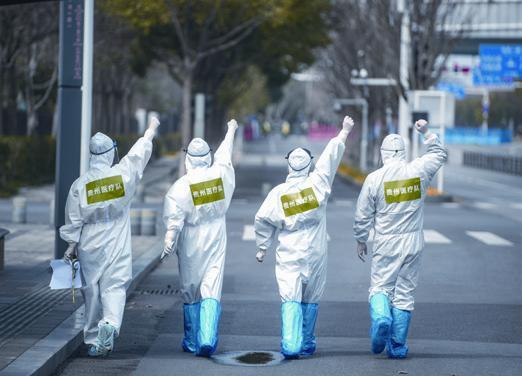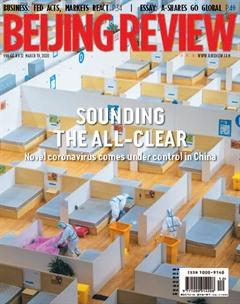A FITTING RESPONSE
By Zhang Weiwei

The novel coronavirus disease 2019(COVID-19) is a disaster facing all humanity, and standing together to find solutions is the right path forward. However, since the outbreak began, Western media reports on China have been filled with xenophobic, racist and derogatory messages trying to smear China and its efforts to combat the disease.
The Wall Street Journal published an op-ed titled China Is the Real Sick Man of Asia written by an American scholar who has a Cold War mindset. U.S. Secretary of Commerce Wilbur Ross suggested the coronavirus would “help to accelerate the return of jobs to North America.” These opinions caused an international outcry.
Righting the record
Nobel laureate Paul Krugman refuted the commerce secretarys remarks in his article in The New York Times on January 30, saying China is the workshop of the world, accounting for more than a quarter of global manufacturing. “If the virus seriously disrupts Chinese production, its impact on the U.S. economy will be like an extreme version of Trumps trade war, except without any compensation in the form of tariff revenue,” he wrote.
Todays world is highly interdependent with interests intertwined. An article in Forbes said “China is at the heart of the electronics supply chain.” Apple saw $27 billion in market value erased following reports about the delayed reopening of its main Chinese iPhone plant. The global car industry has been facing the prospect of a shutdown because Hubei Province, where the epidemic has been the most severe, is a center of the global supply chain of automobiles. Even the U.S. drug supply chain has been disrupted because a vast majority of U.S. medicine ingredients are made in Chinese factories.
Some U.S. politicians proclaimed the coronavirus was an opportunity to decouple the U.S. economy from Chinas. In reality, its not that easy. Its hard to find another supplier country like China which has the most complete supply chain, not to mention its market, the biggest in the world. As long as the epidemic isnt protracted, China will resume its core position among its global partners.
While many countries have supported Chinas measures to control the epidemic, some people from the U.S. have labeled the strict prevention and control measures as a violation of human rights. James G. Hodge Jr., a law professor at Arizona State University, said the shutdown would almost certainly lead to human rights violations, according to The New York Times. The newspaper also published an article, Coronavirus Crisis Shows Chinas Governance Failure, which was questioned by Ho Ching, who is on ForbesPower Women 2019 list and also the wife of Singaporean Prime Minister Lee Hsien Loong. “And what about the influenza B deaths in the USA?” Ho asked on her Facebook page.
A report by the Centers for Disease Control and Prevention shows at least 19 million American people were infected with the influenza virus between October 1, 2019 and January 25, 2020. U.S. President Donald Trump tweeted on March 10 that 37,000 people died from the fl u in 2019.
This proves that some in the West are still paranoid about China. If a crisis of such magnitude occurs in the West, its impossible for their political system to handle it properly. Just look at how the U.S. handled hurricane Katrina in 2005 and the outbreak of the H1N1 virus in 2009, and compare them with how China coped with the devastating earthquake in Sichuan Province in its southwest in 2008 and COVID-19 this time. The conclusion speaks for itself.
On February 12, at a news conference during a research and innovation forum held by the World Health Organization(WHO), a reporter asked if the Chinese Government had prompted WHO to praise it.
Acknowledging countries for the right things they did helps in two ways, WHO Director General Tedros Adhanom Ghebreyesus said. “First, it helps them to continue doing the right thing they are doing; and secondly, it helps other countries recognize the good practice that country which is recognized is doing and they can learn from that country,” he stressed.
On another occasion, the WHO chief said, “What we saw in terms of experience from China is really impressive…Chinas progress in containing the virus should be attributed to government leadership and the cooperation of its people at the same time. It cannot happen without the strong commitment from the government and strong cooperation by the people.”
He applauded Chinas quick move in identifying and sequencing the novel coronavirus pathogen and sharing the sequence with the rest of the world, which has enabled others to test, diagnose and take other responsive actions. “This helped actually the global community to move on. And this is very, very important,” he underlined.
Lessons to be learned
Lets look at how the U.S. handled its H1N1 epidemic outbreak. The U.S. initial response was quick, to be fair. It reported the matter to WHO on April 18 after the fi rst case was found three days earlier.
But the prevention and control measures it adopted failed to prevent the virus from spreading around the globe. The U.S. response to the WHO-designated public health emergency of international concern was merely issuing public alerts and providing medical supplies. It was left to individuals to take preventative measures or seek treatment. As to whether the virus could spread worldwide and claim lives of people in other countries, that was not their concern.
Due to the U.S. Governments inaction, the H1N1 epidemic had affected approximately one fi fth of the U.S. population and 214 countries and regions by the end of 2012, with 284,500 deaths.

The U.S. anti-epidemic campaign was a failure mainly because of the following factors. First, many states were incapable of dealing with an epidemic of such magnitude; the federal government failed to mobilize resources across states. Second, the U.S. was still struggling to recover from the financial crisis—the worst since World War II—with companies shut down and employees fired. Therefore it did not have sufficient capital to handle the emergency and its vaccine production was far from enough to meet the demand. Third, the public didnt protect themselves enough since the government and media both told them that the mortality rate was low.
The different responses by China and the U.S. to epidemics boil down to the differences in their political systems. The U.S. system is underpinned by procedural de- mocracy: As long as the government does not go against established procedures, it will be exonerated from liabilities.
Chinas political system is oriented toward substantive democracy. The government is responsible for the entire nation with almost unlimited liabilities. The Communist Party of China, prioritizing peoples lives and security, is highly capable of nationwide mobilization and coordination. The strong sense of unity and solidarity among the Chinese people makes it easy for them to come together to fight against national emergencies. By practicing self-quarantine and refraining from public gatherings, they showed great self-discipline when confronted with the epidemic.
The Chinese model is also characterized by effective allocation of resources with a collaborative approach. In the anti- epidemic battle, resources were pooled to support the epicenter. Medical workers, volunteers, state-owned enterprises and private companies have all joined in the fight.
Under this political system, the government puts the interests of the people—in China and elsewhere in the world—above all, even at the risk of a domestic economic downturn. Its prevention and control measures helped create a window period for the international community to address the epidemic in concert. The invaluable lessons that China has offered might not be entirely applicable elsewhere in the world, but still, they shed light on what countries can do to effectively curb the outbreak of an epidemic.

